Do you like to sunbathe, but increasingly notice dryness, age spots and other signs of aging skin? Do you want to know what photoaging is, how it manifests itself, what causes it and how to deal with it? After reading our article carefully, you will find answers to your questions.
What information will you find out:
Concept of photoaging
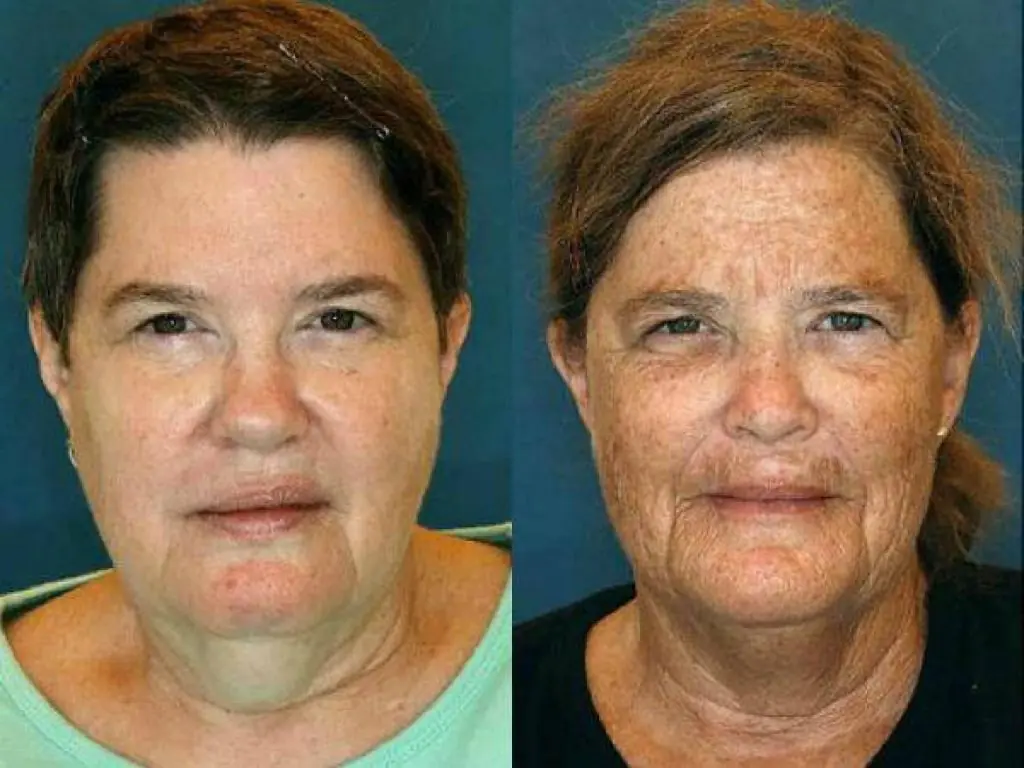
Changes occurring on the surface will necessarily lead to pathological deformations of the deeper layers of the skin
The combination of biochemical, clinical and structural changes in the epidermis caused by constant exposure to ultraviolet rays is called the process of photoaging. Its characteristic features are:
- excessive dryness of the skin;
- extensive brown pigment spots;
- changes in blood vessels in the subcutaneous layer;
- roughness of the epidermis;
- the appearance of small and deep folds/wrinkles;
- decreased firmness and elasticity of the skin surface.
Photoaging is diagnosed using dermatoscopy, biopsy and histological examination of the subcutaneous layer.
How does the photoaging process occur?
It cannot be argued that the sun is necessary for the life and functioning of all life on the planet. Its moderate effect on the skin has beneficial effects, however, excessive use of tanning and constant exposure to direct UV rays provokes pathological processes accompanied by persistent morphological changes occurring at all levels of the skin layer.
Due to regular exposure to type A UV rays, active division of keratinocytes occurs in the skin, which are necessary for regular regeneration and keratinization of the epidermal layer. All possible changes in this process are fraught with heterogeneity of keratinization of the skin surface, leading to its thickening. Changes occurring on the surface will necessarily lead to pathological deformations of the deeper layers of the skin. “Solar elastosis” begins in the dermis, occurring with destruction of elastin structures associated with a violation of their texture, fragmentation, curling and a decrease in the total number. Then foci of chronic inflammation are formed with stagnant processes in the capillaries, leading to a further change in the direction of blood flow and the occurrence of stable vasodilation.
What are the clinical manifestations
In order to see changes in skin exposed to regular UV exposure, you should know 6 main signs of epidermal health, which differ:
- uniform and uniform color;
- excellent tone and elasticity of the skin layer;
- absence of folds/wrinkles;
- normal texture and relief;
- sufficient level of moisture;
- resistance to adverse external conditions and infectious attacks.
The main clinical signs of the initial stages of photoaging are sunburn and pronounced pigmentation of the epidermis.
Signs of chronic UV irradiation include changes in the vascular wall, the appearance of skin tumors, changes in the quality of turgor, and deterioration in the elasticity of the epidermis.
The clinical picture of such exposure is characterized by the formation of areas with impaired pigmentation, freckles, vitiligo, and hypomelanosis. All of these changes contribute to the appearance of small and fairly deep wrinkles in the subcutaneous layer.
In severe cases, the formation of seborrheic keratoses, senile acne, and tumor formations that are difficult to treat is possible!
Preventive and therapeutic measures
All preventive and therapeutic procedures include skin protection from UV rays with the mandatory use of special cosmetic procedures.
Protecting the epidermis from sunlight involves the use of products aimed at reducing the effect of aggressive ultraviolet spectrum. For this purpose, exogenous and endogenous types of drugs called photoprotectors are used.
Endogenous (internal) drugs have properties aimed at obtaining antioxidant and anti-inflammatory effects, reducing the volume of free radicals, and accelerating regenerative processes. Such pharmacological effects are distinguished by vitamins E, C, A, selenium, flavonoids, leukopene, superoxide dismutase, aspirin, as well as photoprotectors of combined action (Imedin, Inneov, Kledist and others).
As external (exogenous) preparations, special products are used, which contain sunscreen filters - SPF. The most reliable are preparations consisting of chemical filters - skinorene and retinoids. With their prolonged use (about six months), the skin texture noticeably improves, the number of wrinkles, white spots, and brown pigmentation decreases.
How to fight photoaging
Aesthetic medicine has a large selection of techniques for successfully combating the effects of photoaging. Medium, deep chemical peels based on the use of various types of acids are considered the most affordable. Such procedures have a comprehensive effect on the epidermis, exfoliating, whitening, and moisturizing the skin layer.
To smooth the skin surface, laser resurfacing, dermabrasion and microdermabrasion procedures are successfully used.
The photorejuvenation method is becoming more and more popular and in demand every day as a manipulation that involves the use of a system of light and thermal energy. The procedure has proven itself only on the positive side due to the minimal number of side effects, excellent tolerability by patients with different types of skin surface, as well as a significant improvement in its condition. After a course of this technique, the texture and turgor of the skin significantly improves, its elasticity and moisture increase, and pigment and white spots disappear.
Be sure to start treating skin photoaging on time to avoid serious consequences, expressed not only in its premature withering, but also in the appearance of life-threatening cancer tumors!
Video: Photoaging of the skin and the fight against it
Many developments in the field of medical cosmetology and dermatology are devoted to the problem of early skin aging. In medicine, the process of permanent skin damage is called photoaging. It arises as a result of the fashion for tanning.
Cosmetologists pay close attention to process correction. Data obtained from research shows that strong insolation causes premature age-related changes, which in general worsen the condition of the skin even more than stress and the environment.
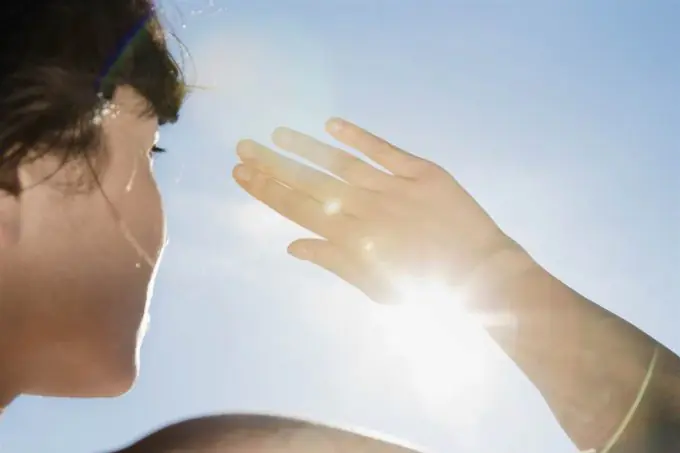
Researchers were able to make significant progress by studying the topic of photo damage. Increasing life expectancy and the desire of many to improve skin color under the influence of ultraviolet rays and solariums have intensified the market for products aimed at solving these problems. Emerging trends may lead to the emergence in the near future of new developments that protect the skin from the dangerous effects of ultraviolet radiation.
Clinical picture
Cosmetologists identify signs of photoaging, based on which it is possible to recognize that the skin is healthy or aging. Healthy skin is elastic, has uniform color, normal texture, and moisture. The second often has thin and dry skin. It is possible to determine the characteristic signs of photoaging much earlier than age-related changes appear. They manifest themselves exclusively in open areas that have been exposed to ultraviolet radiation.
In these cases, increased wrinkle formation, trauma, and decreased elasticity are observed. This is due to the presence of dermal disorders. Pronounced epidermal changes appear when normal skin color is disrupted (lentigo) and diffuse hyperpigmentation occurs.
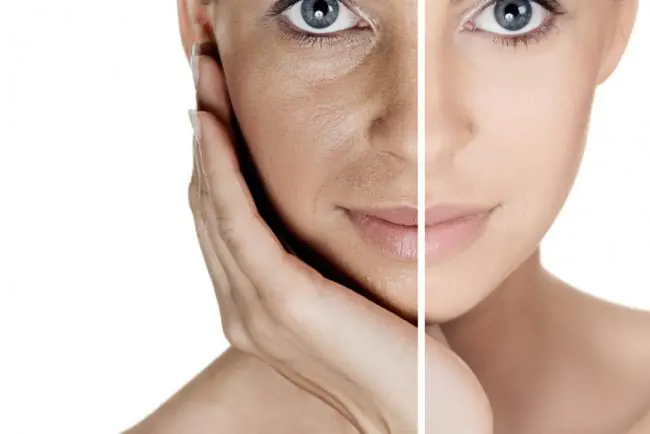
The risk group includes menopausal women with skin phototypes I-II. They are predisposed to photoaging. Medical studies do not confirm the effects of oral contraceptive use and smoking.
It has been established that smokers exhibit more active skin photoaging (photoporation helps), since smoking contributes to the appearance of wrinkles and leads to deterioration of complexion. Men with dark skin color are most prone to the appearance of such changes.
Histological signs of photoaging
Scientific research has established that the stratum corneum of the epidermis shows signs of hyperkeratosis, while the thickness of the epidermis may not change. It contains hypertrophy and atrophy. Basal keratinocytes may be damaged, causing the basement membrane to thicken. The number of melanocyte processes and pigment accumulation will be uneven along this line.
A direct relationship has been established between the level of damage and the power of exposure to UV radiation over many years. This is most significantly manifested in the destruction of elastin fibers, which make up various components. Another manifestation of phytopathology in the skin is basophilic collagen degeneration, when undamaged collagen areas are replaced by collagen.
Such processes can be traced in pronounced areas. The most severe manifestations of photopathology include the appearance of areas in which there is an accumulation of glucose-minoglycans, which are responsible for the strength characteristics of cell membranes.
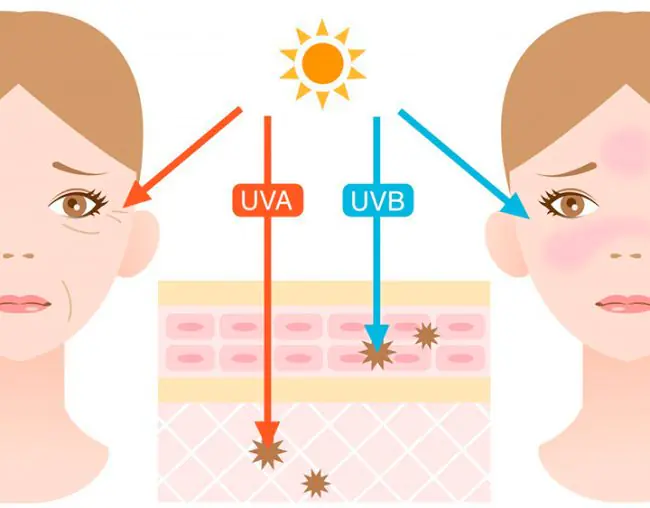
Based on the wavelength, ultraviolet has the ability to relate to various skin cells located in different deep layers. Ultraviolet radiation, which has a short wavelength (part B, 280-320 nm), can be absorbed by the epidermis.
Photoaging occurs in areas where damaged keratinocytes are present. Longer waves penetrate deeper. Such processes contribute to their interaction with epidermal cells and fibroblasts. The difference between melanin is the absorption of ultraviolet radiation. Due to this, the cells are protected from destruction. The portion of the spectrum that penetrates the barrier has a negative effect on tissue in a variety of ways.
UVA rays have the ability to act indirectly. They help produce free oxygen radicals. The process of lipid peroxidation may occur, which causes breaks in DNA chains.
The ability of UVB is to produce free forms of oxygen. Such rays have the ability to have a direct damaging effect on DNA due to the direct activation of special substances associated with transcription factors. Through them, the process of production of metalloproteinase in cells is started. These are enzymes that have increased degrading activity in relation to cell building proteins.
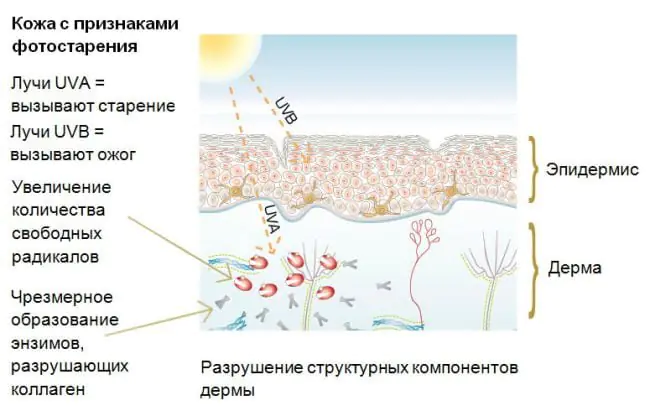
Statistics show that skin photoaging affects people with fair skin. The protective potential has the ability to decrease significantly with unsatisfactory melanin production. Therefore, those who have such skin need to be extra vigilant when sunbathing.
Those with dark skin also need to pay increased attention to the effects of sun rays. When sunburn is not present, it cannot be said with certainty that the epidermal cells have not been damaged. The risk group is dominated by women during periods of hormonal imbalances. The functioning of hormones is directly determined by the activity of melanocytes. If the balance of estrogen and progesterone is disturbed, the skin's sensitivity to the effects of sunlight increases. As a result of such processes, cell regeneration slows down.
Diagnostics of the endocrine system
If skin problems arise, a dermatologist or cosmetologist will help. If there are suspicions of problems with the endocrine system, then consultation with an endocrinologist is required. A blood test is ordered to determine hormone (estrogen) levels.
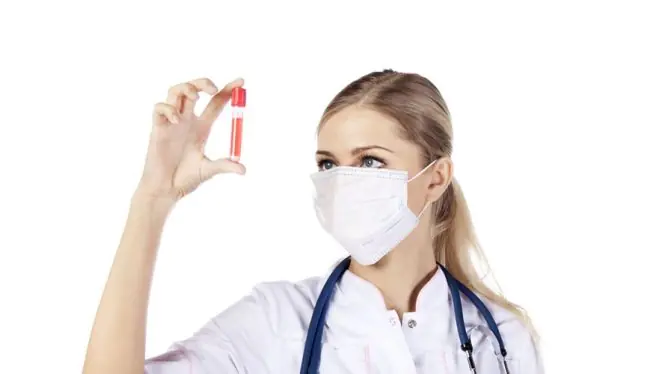
Ways to eliminate photoaging
For patients with signs of photoaging, photoprotection and certain treatment procedures are indicated. These are activities that reduce exposure to UV rays. The cosmetologist selects them based on the nature of skin changes.
Despite new developments in the field of cosmetology, it is impossible to achieve eternal youth. But still, you can “deceive nature and lose a few years” by resorting to effective cosmetic procedures.
Photoaging can be prevented using various methods. Biorevitalization involves injecting hyaluronic acid under the skin. In the process there is a moisturizing effect on the skin. As a result, it becomes elastic and resilient. You can use a similar procedure when the characteristic features of early aging appear, starting from the age of thirty. The whole process lasts no more than an hour. Its feature is its prolonged action, which can maintain the result for several months.
Dermabrasion, carried out using attachments and abrasive materials, is considered an effective procedure. You can get a clear effect a few weeks after its implementation. This procedure allows you to get rid of age spots and scars. When performing a chemical peeling procedure, retinol and glycol are used. Under the influence of this process, collagen synthesis is activated. Thus, it is possible to enhance the process of restoration of the epidermis and stop photoaging.
Laser skin resurfacing helps get rid of serious scars. With its help, you can eliminate old cells and regenerate new ones. Cosmetologists call mesotherapy an effective method. A few sessions are enough for the patient to forget about dry skin and shallow wrinkles. This procedure involves the introduction of therapeutic cocktails.
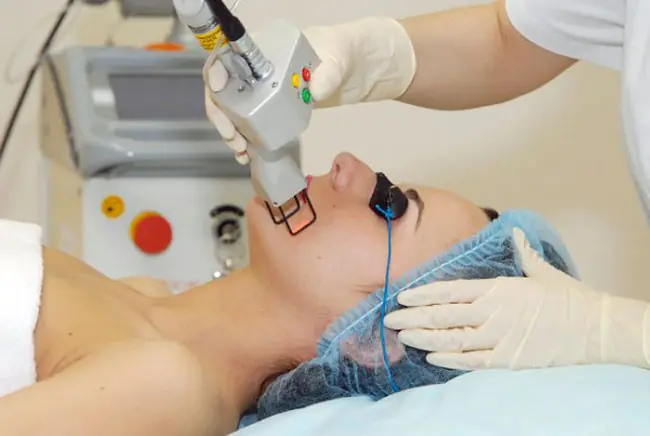
Photorejuvenation techniques can hide the effects of premature skin aging. When prescribing a procedure, a cosmetologist is guided by the status of skin photoaging according to IC 10. When a session is performed, the skin is exposed to a pulsating stream of light. Under its influence, cell division accelerates and skin elasticity increases. Metabolism also improves.
Those who want to have an even, attractive tan without exposing their skin to ultraviolet radiation should use the self-tanning procedure. The skin acquires a golden hue, the skin tone is evened out or depigmented areas (vitiligo) are hidden.
The products used contain ketosaccharides or derivatives of glucose and fructose. These products do not have a harmful effect on the body, as they do not contribute to the formation of melanin. Cells do not change.
Before the self-tanning procedure, peeling is required so that the thickness of the stratum corneum becomes the same. During this period, the use of scrubs and acid peels is indicated. The quality of tanning improves if you eat foods rich in carotene (carrots, oranges).
Preventing sun exposure
To avoid photoaging outside the season when the weather is sunny, you must use sunscreen. In summer, it is better to use a cream with an increased SPF of at least 30. Those who have fair skin should use a cream with an SPF of at least 50. In early autumn, it is necessary to use BB creams that protect it and maintain moisture balance. Their application evens out the tone without clogging the pores.
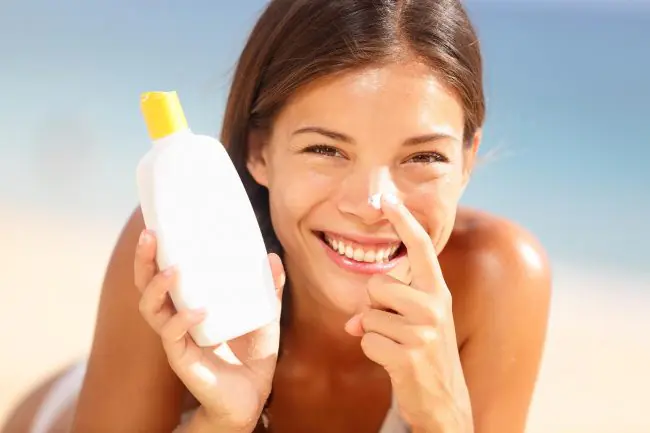
When taking baths, both in natural conditions and in a solarium, you must strictly adhere to the rules of tanning. It should be remembered that exposure to the sun and solarium should be strictly dosed. Otherwise, the risk of acquiring skin melanoma increases.
Also, increased attention should be paid to creating a balanced diet. Vegetables and fruits rich in beta-carotene should always be present on the table. These include tomatoes, spinach, apricot and bell pepper. This substance helps synthesize melanin.
Prevents photoaging by taking dietary supplements that contain antioxidants. Vitamins E, A, C, selenium, flavonoids, etc. have pharmacological effects. You should also use sunscreens, which must be of high quality. External protection from ultraviolet radiation is provided by photoprotectors, as in photoporation, which improve skin texture and reduce wrinkles. Under their influence, local pigment areas become less pronounced.
In summer, you should wear light-colored clothing that covers most of the body. You need to wear glasses, hats and panama hats. Upon returning from vacation, it is necessary to use nutricosmetics that contain antioxidants.
It will significantly reduce the risk of skin damage. Creams and lotions based on chamomile, aloe, lavender and candea oils have a good moisturizing effect. Natural skin hydration must be combined with antioxidant cosmetics. Hyaluronic acid is recognized as an effective moisturizer that stops photoaging.
Cosmetologists believe that in 70% of cases, the skin ages not from age, but from exposure to ultraviolet rays. Fight the Sun itself - modern cosmetics cope with this ambitious task.
- What is photoaging
- What you need to know about skin photoaging
- Who is most susceptible to skin photoaging?
- How to fight photoaging
- Salon treatments against photoaging
- Tools Overview
What is photoaging
Do you know how a tan appears? To protect skin cells from possible damage, melanocytes absorb sunlight, producing a dark pigment. As a result, the skin becomes darker. If active exposure to the sun stops, the skin brightens again as its cellular composition is renewed. In young skin this process takes approximately 28 days.
Over the years, the system begins to fail. Dark spots form on the skin - a manifestation of hyperpigmentation. But this is not the biggest problem yet. What is much more unpleasant is that ultraviolet radiation penetrates into the deeper layers of the skin and promotes the formation of free radicals. Those, in turn, damage collagen fibers - and hello, premature wrinkles.
What you need to know about skin photoaging
This process can start very early. Even at 20–25 years old. It all depends on how long and how often you spend time in the sun or go to the solarium (you definitely don’t need to do this). Scientists say that sun damage begins to accumulate almost from birth. But let's not talk about sad things. It’s better to list the signs by which you can understand that your skin is suffering.
- The skin became rougher.
- The complexion looks uneven. It is even possible to form solar lentigo - areas with excess pigmentation.
- The tone, firmness, and elasticity of the skin decreased prematurely.
- Spider veins appeared.
Ultraviolet light penetrates everything, including the deeper layers of the skin, and promotes the formation of free radicals. © iStock
Who is most susceptible to photoaging?
Let's list the main risk groups.
They are at risk from birth. And the lighter the skin, the more careful you need to be. In summer, wear wide-brimmed hats and long sleeves to help protect against UV rays. After the sea, I want to show off my beautiful tan. But you should always remember that it is better for your skin to under-tan than to over-tan.
“Bad” changes accumulate. Once you get burned, the process of photoaging begins, which will only progress. Therefore, it is very important to always protect your skin from the sun.
Don't forget about children - their skin is even more delicate than adults. According to research by American dermatologists, sunburn before the age of 10 doubles the risk of skin cancer after 40 years.
The fact is that the activity of melanocytes depends on hormones. During hormonal changes (adolescence, pregnancy, the postpartum period, menopause) or against the background of hyper- and hypothyroidism, an imbalance of progesterone and estrogen increases the skin's sensitivity to solar radiation.
Cigarettes are not beneficial at all, but they are especially harmful to the lungs and skin. The skin becomes thinner, acquires a grayish-yellowish tint - and becomes more susceptible to photoaging.
In a solarium, ultraviolet rays type A (UVA) work in high doses. With less aggressive radiation, clients will be unhappy - a quick tan will not work.
Meanwhile, UVA penetrates into the deep layers of the skin and destroys its “building materials” - elastin and collagen.
The ideal moisturizer is one that, in addition to active caring ingredients, has an SPF of at least 15. © iStock
How to fight photoaging
The simplest thing, as we have already said, is to avoid the sun when it is especially active and not to get carried away with going to the solarium. And also eliminate other risk factors - quit smoking, do not overexpose yourself to the sun during hormonal changes. And, of course, actively use cosmetics with SPF, which combines two types of filters:
- physical, reflecting the sun's rays;
- chemicals that stimulate melanin production.
An ideal moisturizer, in addition to active caring ingredients, contains SPF not lower than 15. And vitamins C and E - renowned cell protectors and free radical fighters.
In summer, be sure to use cream with SPF. But remember that from 11:00 to 16:00, when UV rays are especially active, it is better to stay in the shade. Also keep in mind that the activity of sunscreen is reduced by half within an hour after application, and after three hours it stops working completely.
Don't forget about food. Fruits and vegetables contain many useful substances - those rich in vitamins A, C, E are especially valuable for the skin.
Salon treatments against photoaging
In addition to well-chosen cosmetics and a balanced diet, salon procedures will help slow down photoaging.
- Biorevitalization - injections of hyaluronic acid. They prevent the harmful effects of UV rays, since hyaluronic acid is an antioxidant and has powerful anti-inflammatory properties. In addition, it improves skin tone and makes it more elastic.
- Chemical peels help cope with hyperpigmentation, accelerate cell regeneration and collagen synthesis.
- Dermabrasion eliminates the accumulation of horn cells and stimulates the renewal of the epidermis.
- Mesotherapy: cocktails of amino acids and vitamins are injected into the skin, which have an antioxidant, restorative and renewing effect.
- Photorejuvenation - perhaps the most effective method aimed at combating photoaging. Pulses of light waves of a certain length affect the skin and stimulate the synthesis of collagen fibers. Cosmetologists say that after a course of procedures, even deep wrinkles disappear and the condition of the skin improves significantly.
In addition to cosmetics and products, salon procedures will help slow down photoaging. © iStock
Tools Overview
Cream Revitalift “Laser X3”, SPF 20, L’Oréal Paris
glycopeptide proxylane, lipohydroxy acid, UV filter
Reduces wrinkles and pigmentation, protects against sun exposure, provides anti-aging care.
Sunscreen “Expert Protection”, SPF 50+, Garnier
vitamin E, UV filter
Ideal for very fair skin. Prevents the appearance of age spots.
Corrective cream City Miracle CC Cream, SPF 50, Lancôme
salicylic acid, vitamins A, B and E, UV filter
Masks skin imperfections and protects against UV rays.
Skin Best Day Cream, SPF 15, Biotherm
spirulina extract, antioxidant astaxanthin, UV filter
Moisturizes and nourishes the skin, enhancing its antioxidant protection. Reduces the negative effects of UV rays.
| Name | Active components | Action |



